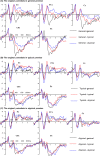How types of premises modulate the typicality effect in category-based induction: diverging evidence from the P2, P3, and LPC effects
- PMID: 27982022
- PMCID: PMC5159785
- DOI: 10.1038/srep37890
How types of premises modulate the typicality effect in category-based induction: diverging evidence from the P2, P3, and LPC effects
Abstract
Behavioural studies have indicated that semantic typicality influences processing time and accuracy during the performance of inductive reasoning (i.e., the typicality effect). The present study examines this effect by manipulating the types of premises and conclusions (i.e., general, typical, or atypical) at an electrophysiological level using a semantic category-based induction task. With regard to behavioural results, higher inductive strength was found in typical conclusions in all premise conditions, whereas a longer response time for atypical conclusions was only found in general and typical premise conditions. The ERP results had different response patterns: in the general premise condition, a larger P2, as well as a smaller P3 and LPC (500-600 ms), were elicited by atypical conclusions relative to typical ones; in the typical premise condition, a larger P2 and LPC (600-700 ms) were found for atypical conclusions; in the atypical premise condition, however, only a larger P2 was found for atypical conclusions. The divergent evidence for the typicality effect indicated that the processing of the typicality effect in general, and specific premise conditions, might involve different cognitive processes, such as resource allocation and inference violation, which yielded new insights into the neural underpinnings of the typicality effect in a category-based induction.
Figures



References
-
- Osherson D. N., Smith E. E., Wilkie O., Lopez A. & Shafir E. Category-based induction. Psychological review 97, 185–200 (1990).
-
- Räling R., Holzgrefe-Lang J., Schröder A. & Wartenburger I. On the influence of typicality and age of acquisition on semantic processing: Diverging evidence from behavioural and ERP responses. Neuropsychologia 75, 186–200 (2015). - PubMed
-
- Holmes S. J. & Ellis A. W. Age of acquisition and typicality effects in three object processing tasks. Visual Cognition 13, 884–910 (2006).
Publication types
LinkOut - more resources
Full Text Sources
Other Literature Sources

